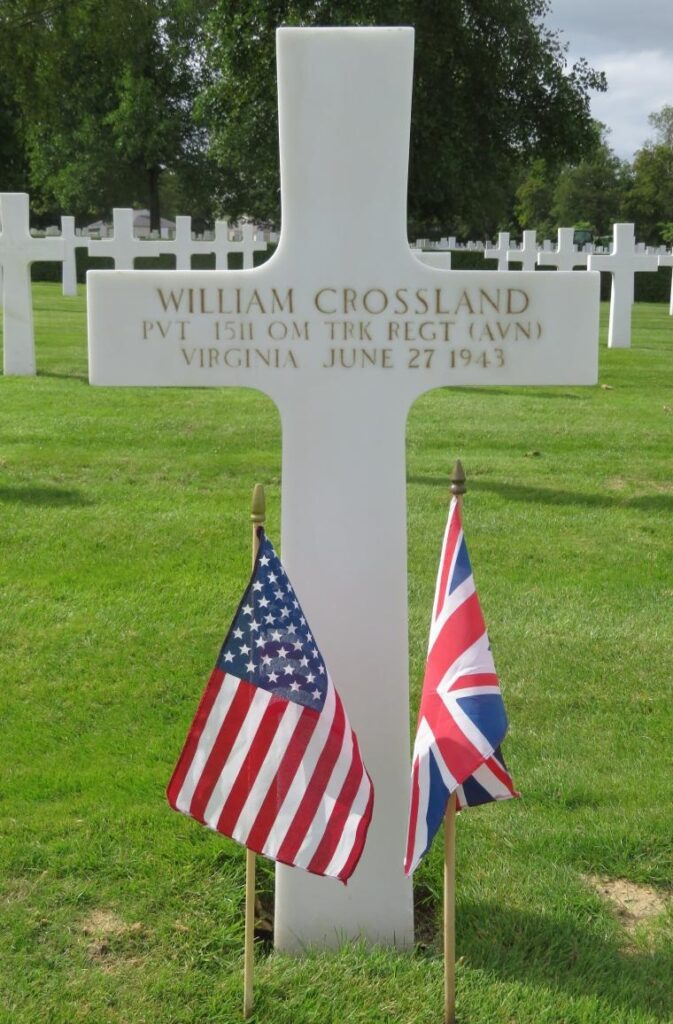Bamber Bridge: American Racial Tension in the UK
A little known battle during WWII didn’t occur between the Axis and Allies; rather it occurred between Black and White members of the U.S. Army. In this episode, we tell the story of what happened in the small village of Bamber Bridge in England during a time of extreme racial tension.

Prior to the 1950s, the United States Military was entirely segregated. Black Americans were not allowed to serve in the same unit as White Americans. When the U.S. drafted people for World War One, the numbers show that Black Americans were drafted more often than White Americans, particularly in the South – they made up 10% of the U.S. population, but were drafted at a rate of 13%.
By the time the second World War came around, it was starting to become known that Black soldiers weren’t receiving the same treatment as White soldiers and this impacted their ability to serve. Black soldiers had fought in every previous American conflict, yet they were facing exclusion and discrimination at every turn. They were disproportionately given service jobs and support roles rather than front line combat or command staff. Some efforts were made to address this like the nondiscrimination language in the Selective Service Act of 1940, but the Army’s treatment of Black soldiers continued to be less than ideal. The push for desegregation didn’t begin until 1948. Roosevelt had set the quota for Black soldiers at 9%, but the Army never reached that percentage during World War II. Other nations where our Army was serving sometimes initiated this discrimination and exclusion. As a result, most black soldiers were never sent overseas during the conflict. Many who volunteered for combat roles had to give up their rank and take a pay cut.
This week’s story revolves around a Black Regiment in World War II that did serve overseas: the 1511th Quartermaster Truck Regiment. It was part of the Eighth Air Force and their job was to deliver supplies to Eighth Air Force bases in the region. During World War II, they were headquartered in a place called Bamber Bridge. This is a small town in Lancashire, South of Preston in England and to find it in a map, you go Northeast from Liverpool and Northwest from Manchester. The 1511th was made up of all Black soldiers. As far as the Officers, all but one were white and all of the Military Police on the base were white. And one of the things that the Army tended to do in the days of segregation was dump less competent officers on these Black regiments. So if an Officer was causing trouble or unwanted by the White regiments, they would assign them to groups like the 1511th Quartermaster Truck Regiment. And that’s how they got people in their command staff like Captain Julius F. Hirst and Lieutenant Gerald C. Windsor.
Jim Crow was alive and well – even on American bases in England. There was an order by the United States Military to segregate the pubs in England. They didn’t want Black service members drinking in the same places as White service members. And while this had been the standing order, something happened back home in 1943 that exacerbated the issue. Tensions were already high within the 1511th due to horrible discriminatory conditions. The black soldiers were receiving barely edible food and were ordered at times to sleep in their trucks. They were already unhappy with their mostly white Command staff, so when race riots erupted back home, everyone took notice.
In Detroit, Michigan, race riots in June had led to $2 million in property damage, 6,000 troops responding, 433 injuries and 34 tragic deaths. Racial tensions were at a high point and – in addition to an influx of immigration amid a housing crisis, much of the angst that led to the riots had to do with social unrest due to the War effort and the fact that Detroit had converted its auto-making capabilities to help the war effort. A false rumor about a mob of White people who had murdered a Black baby started the riots and the violence spread from there.
In response to these race riots, the Military Commanders felt emboldened in their decision to segregate not only Army units, but even the social actions of service members like visiting English pubs. In many places, the Army put in place a rule where White soldiers could visit pubs on certain days of the week, Black soldiers on others.
They demanded that the English provide at least one separate bar for people of color. But the English locals didn’t like the idea. Racial tensions in the UK at the time weren’t as severe as in the United States. The English saw Black Americans as Americans – deserving of the same treatment as any U.S. Soldier. And so the people of Bamber Bridge respected and supported the Black troops of the 1511th and as a protest to the segregation order, all three of the town’s pubs put up signs reading “Black Troops Only.” You can imagine how this was received by the almost all-White command staff and MPs.
It was only 3 days after the Detroit Race Riots when the incident took place. After the Detroit riots, the Command staff for the 1511th was on edge thinking about racial tensions. It was normal for the soldiers of the unit to frequent the local pubs and on June 24th, a group of them were enjoying themselves with some British locals, including ladies from the Auxiliary Territorial Service and they were all having drinks at a pub called Ye Olde Hob Inn. At this point, there are a few differing accounts of exactly what happened, but it’s clear that there wasn’t initially any sort of issue. One account stated that the Black soldiers were drinking later than what the law allowed. Nonetheless, Two MPs were called by Command to report to the pub to deal with a problem. It seems like the only problem was that the soldiers were committing a few very minute offenses. They had standing orders to arrest soldiers who were out of camp without the proper pass or who were not in the proper uniform.
When the Military Police entered the pub, they saw Private Eugene Nunn from the 1511th. He was in uniform, but dressed in a field jacket rather than the Class A Uniform the regulations said he should be wearing. They asked him to step outside. A few of the local British Military members tried to intervene explaining that he wasn’t bothering anyone or hurting anybody. The only black officer of the 1511th, Staff Sergeant William Byrd calmed the situation down and convinced the MPs to let it slide. As the MPs got back to their jeep and were about to drive away, all hell broke loose. Someone threw a beer bottle at their car. What happened next is now known as the Battle of Bamber Bridge.
We’ll tell you all about it after a quick break.
The situation at Bamber Bridge on June 24, 1943 was all but defused when someone threw a beer bottle at the truck of the Military Police. The two MPs were on their way back to the base, convinced by Staff Sergeant William Byrd to leave the soldiers alone.
Last year in 2023, the Black History Group of the city of Preston located Eunice Byers. And at the age of 106, she is the last surviving witness of what happened that night in Bamber Bridge.
The MPs, Corporal Roy A. Windsor and Private First Class Ralph F. Ridgeway, picked up two more reinforcements and reported to Captain Hirst and Lieutenant Gerald Windsor and were ordered to find and arrest the soldiers at the pub. By this point, the soldiers were walking back to the Mounsey Road base and when they got to Station Road, the four Military Police riding in their Jeep with a machine gun mounted to the top, caught up to the soldiers and a fight broke out.
The soldiers knew there was about to be trouble. In fact, some of them had walked up and down the street telling locals to stay inside because there was about to be a fight. Others went back to base and raided the armory.
This entire skirmish – not between the Axis and Allies, but between Black and White US Troops – was about to explode. And it was all caused by a Command staff who was looking for any excuse to punish black soldiers. The fighting that night wasn’t caused by one man being in the wrong uniform. It was likely just the straw that broke the camel’s back after months and months of building racial tension, and of course made worse by reports of riots back at home.
History doesn’t know who fired first – the White MPs with a Jeep-mounted machine gun or Black Soldiers who had armed themselves with guns taken from the base’s armory. But within the next several hours, the main thoroughfare of the town of Bamber Bridge was filled with gunfire. At least 400 shots rang out on Station Street, lasting until the next morning.
Here’s Clinton Smith from the Preston Black History Group describing the battle.
Private William Crossland from Pittsylvania County, Virginia had been shot in the back and killed. An officer, one member of the Military Police and 3 of the GIs had also been shot and injured. Two other soldiers had been badly beaten. By 4am, the fighting was over as the MPs were ordered to cease firing. The Battle of Bamber Bridge had ended, but the matter wasn’t over.

Immediately after the fight, a military court martial was held against 32 of the Black Soldiers. They were accused of mutiny and related crimes. By August, four of the soldiers who were involved were sentenced to several years of hard labor and dishonorably discharged. One of those sentences was overturned on review. But a second trial was held the next month and in September, 28 more of the soldiers of the 1511th were convicted. Their sentences for mutiny ranged from 3 months to 15 years. Now there was again a review of these sentences and all of them were reduced. Most of these soldiers were free and returned to duty by the following summer. None of the MPs or Command Staff saw any sort of punishment. Not even the one who killed Private Crossland. According to the Courts Martial, al of the blame was placed on the Black soldiers.
But the Commander of the Eighth Air Force, General Ira C. Eaker, saw things differently. He thought the Officers bared most of the responsibility. He had heard the reports of how the White leaders had mistreated the soldiers of their unit, including providing poor eating and sleeping conditions and even went so far as to frequently use racial slurs. The result of his assessment was a decision – in combination with President Harry Truman’s Executive Order 9981 of 1948 to integrate the US Army – to combine the trucking units of the Eighth Air Force into a single unit. Officers that were found to be inexperienced, inept or overtly racist were kicked out. MPs also became racially integrated.
I had trouble finding any contemporaneous newspaper articles detailing the Battle of Bamber Bridge. And what I discovered was that the entire ordeal was censored to protect the American Army from embarrassment and further race riots throughout the armed services. And while there were a couple other similar racial battles within the Army, Bamber Bridge was the worst.
Today, only one of the barracks on Mounsey Street remains. But In the late 1980s, a maintenance worker Clinton Smith was cleaning the exterior of the Nat West Bank in Bamber Bridge. He found some bullet holes in the woodwork of the building and began to ask around how they got there. Back then, there were still people alive to tell the story. This reinvigorated the discussion and publicity around the Battle of Bamber Bridge and the fascination with a military battle in England during World War II that didn’t involve the enemy.
The Battle of Bamber Bridge was a precursor to the American Civil Rights movement. It was used as an example of why racial integration in the military was necessary in the following years. The contrast between the way American Southerners treated Black Americans versus how they were treated by the English was a stark depiction of how Jim Crow was affecting American race relations. It’s an ugly part of American history, but important to tell the story. Like Tulsa Oklahoma, Clinton Mississippi, Wilmington North Carolina, Colfax Louisiana and dozens of others, it’s a story that was covered up and hidden because it was embarrassing to admit the difficult history this country has with Civil Rights and race relations. But the Internet Says it’s True.



